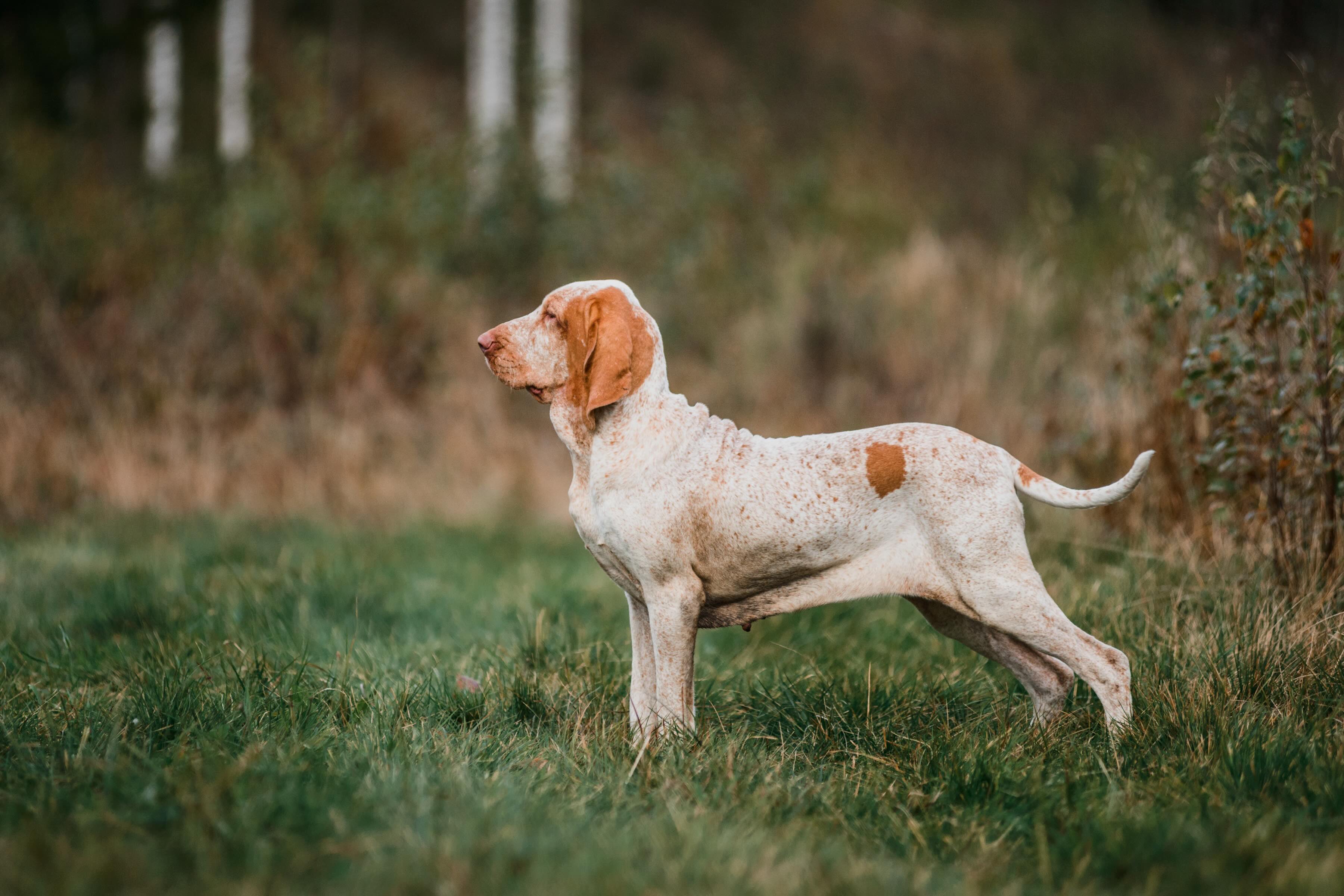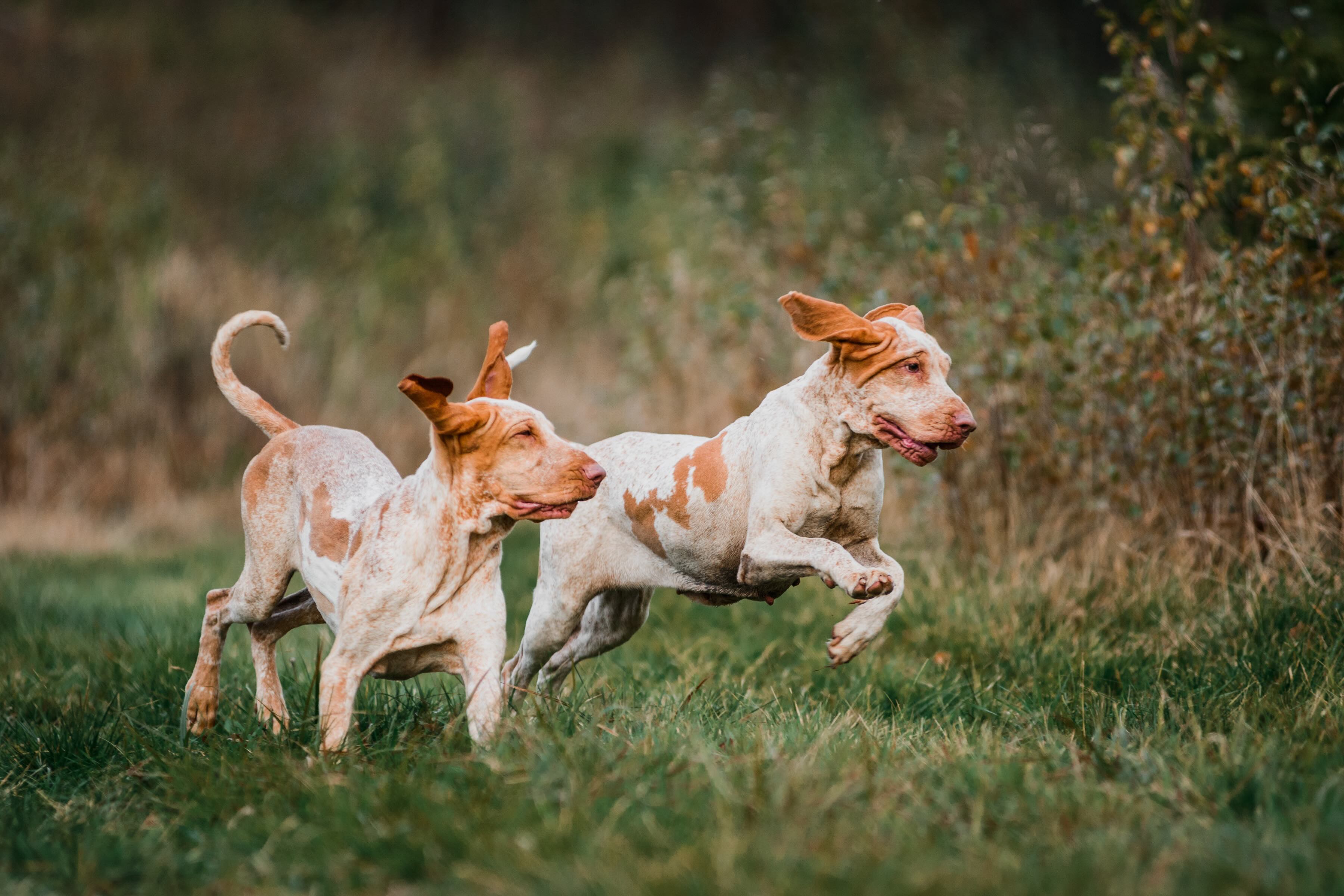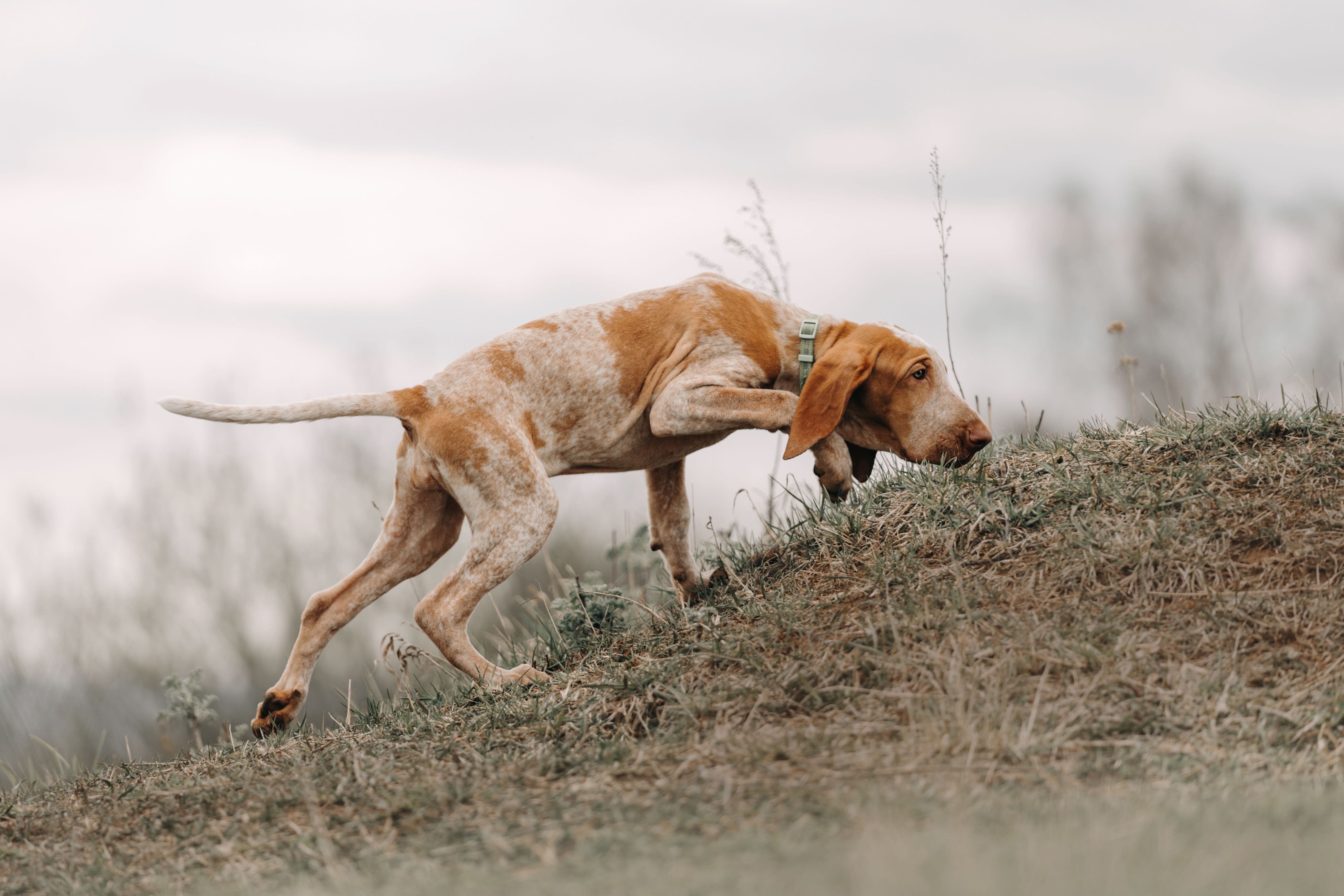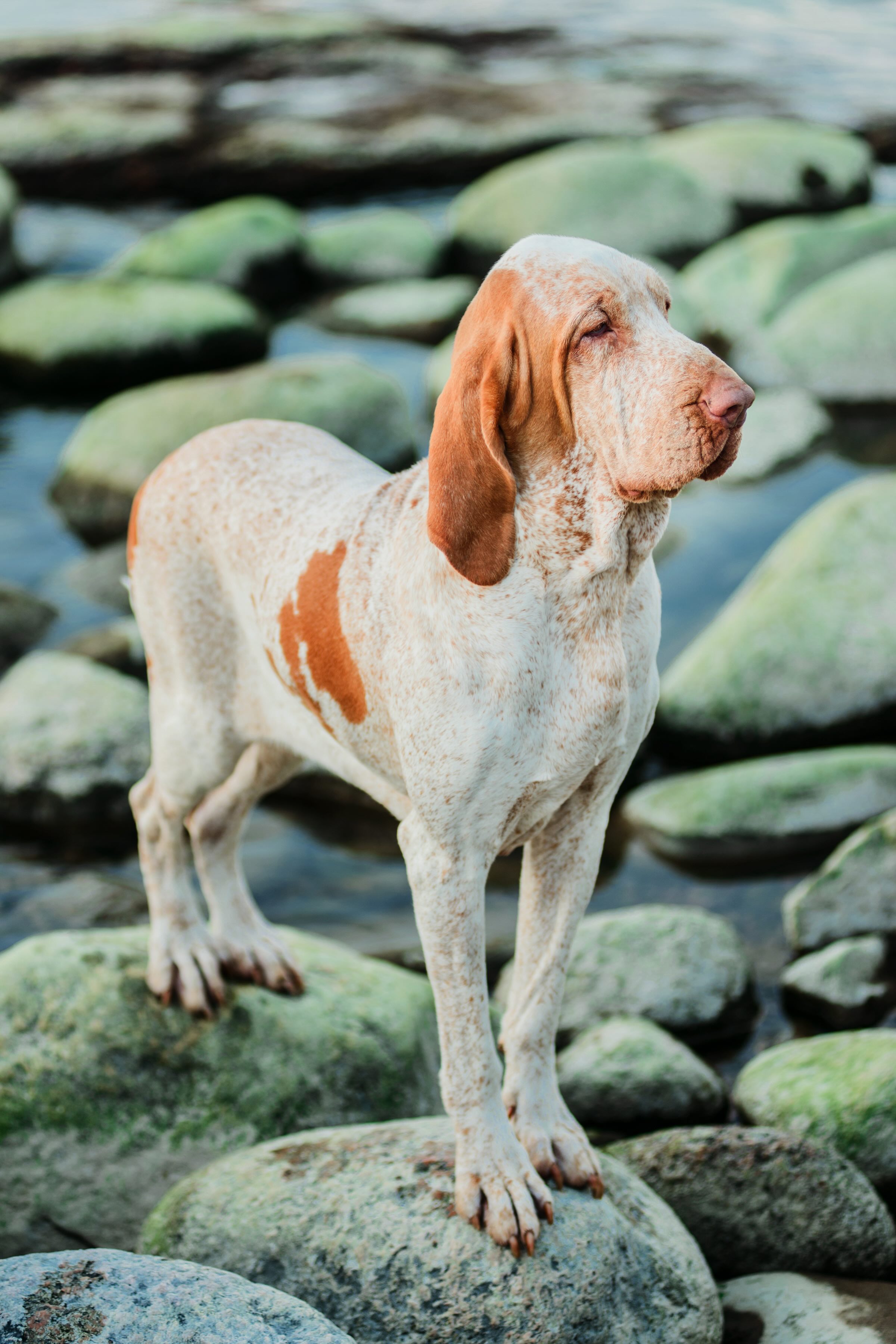Bracco Italiano
Ksenia Raykova/iStock / Getty Images Plus via Getty Images
The Bracco Italiano, one of Italy's oldest and most distinguished pointing dog breeds, has roots dating back to the fourth or fifth centuries BCE.
Originally bred by Italian nobility, the breed served as an exceptional game hunter, combining tracking skills with the ability to point out prey, according to the Bracco Italiano Club of America (BICA). Today’s Bracco Italiano dogs have remained highly valued by hunters and stayed largely unchanged over the centuries.
Physically, the Bracco Italiano dog breed is known for having a powerful, athletic build. The dogs typically stand 21–27 inches tall and weigh 55–88 pounds.
The Bracco Italiano’s head features a long, well-sculpted nose and expressive eyes, giving them a noble and intelligent appearance. Their short, dense coat is usually white with chestnut or orange markings.
Caring for a Bracco Italiano
The Bracco Italiano is a versatile and loyal breed, known for a gentle temperament and keen intelligence.
Pet parents can expect a companion that’s affectionate, social, and eager to please, making the Bracco a great family dog and a cooperative partner in the field. Bracchi Italiani are generally good with other dogs and with children, thanks to their easygoing and patient nature. But their hunting history and prey drive might tempt them to chase smaller animals, like neighborhood squirrels.
A high-energy breed that thrives with regular exercise and mental stimulation, the Bracco Italiano requires daily activities such as long walks, playtime, or field training sessions to keep them happy and prevent boredom. Outdoors, they are tireless. But indoors, they are calm dogs—if they’ve had enough physical activity.
Bracco Italiano Health Issues

The Bracco Italiano is generally considered a healthy breed with an average lifespan of 10–14 years. That said, the dogs are susceptible to some health issues.
Kidney Disease
“The number one problem we are seeing in the breed is kidney disease,” says Valerie Kessler, co-founder of the Bracco Italiano Health Foundation. This occurs when the kidneys are no longer efficiently filtering waste from the blood and converting it into urine.
Kidney disease in Bracco Italiano dogs is hereditary and, in some cases, caused by amyloidosis. Unfortunately, kidney disease ultimately leads to kidney failure. Common symptoms of kidney failure include:
Because kidney disease can be progressive and challenging to manage, early detection is essential. Regular blood work and urine tests can help identify kidney problems early. Work with your veterinarian to develop a tailored treatment plan, which may include dietary changes, medications, and supportive care.
Hip Dysplasia
Hip dysplasia is a common condition in large dogs like the Bracco Italiano. This issue can be genetic or caused by environmental factors such as nutrition, exercise, and weight. Hip dysplasia affects the hip joint: The ball and socket don’t fit together properly, leading to pain, inflammation, and eventually arthritis.
Signs may include lameness, difficulty standing, or reluctance to exercise. To manage hip dysplasia, veterinarians may recommend weight management, anti-inflammatory medications, or joint supplements. In more severe cases, surgery might be necessary.
Elbow Dysplasia
Elbow dysplasia, another joint-related issue, occurs when the elbow joint doesn't develop properly. This can cause pain and may limit a dog’s mobility. Symptoms include limping or a stiff gait, particularly after physical activity.
Treatment for elbow dysplasia varies from weight management and anti-inflammatory medications to physical therapy or surgery in severe cases.
Ear Infections
Due to their long, drooping ears, Bracchi Italiani are prone to ear infections. Symptoms of ear infections can include head shaking, ear scratching, and odor. Routine ear cleaning can prevent infections, but pet parents should be careful not to overclean, which can irritate the ear canal.
Bloat and Gastric Dilatation-Volvulus (GDV)
Gastric dilatation-volvulus is a serious and potentially life-threatening form of bloat in dogs. GDV affects deep-chested breeds like the Bracco Italiano and happens when the stomach fills with food and gas, twists, and cuts off blood flow, leading to severe complications.
Symptoms include:
-
Distended abdomen
-
Restlessness and pacing
-
Retching without producing vomit
Amanda Lee Inman, president of the Bracco Italiano Club of America, says many Bracco pet parents opt for a preventive gastropexy surgery, which is often performed at the same time as a spay or neuter procedure.
Other preventive measures for bloat include feeding your dog smaller, more frequent meals and limiting exercise directly before or after eating.
Progressive Retinal Atrophy (PRA)
Progressive retinal atrophy (PRA) is an inherited eye condition that can lead to blindness over time. Early signs include night blindness and a reluctance to move in dim lighting.
While there’s no cure, PRA doesn’t typically cause pain, and most affected dogs adapt well to vision loss. Regular eye checkups can help monitor this condition, and environmental adjustments can assist dogs as their vision declines.
Skin Allergies
Bracchi Italiani can be prone to skin allergies, which often manifest as itching, redness, or recurring skin infections. These allergies can be severe and are triggered by environmental factors, like pollen or dust mites, or by certain foods. Common signs include excessive scratching, licking, or ear inflammation.
What To Feed a Bracco Italiano

When choosing dog food for a Bracco Italiano, it's essential to consider your dog’s unique nutritional needs, activity level, and potential health issues. A high-quality dog food should meet the standards set by the Association of American Feed Control Officials (AAFCO).
If you suspect your Bracco has a food allergy, work with your veterinarian to find a food suitable for your dog.
How To Feed a Bracco Italiano
Bracco Italiano puppies benefit from three small meals per day to fuel their growth, while adult dogs do well with a twice-a-day feeding schedule. A structured feeding routine is essential for Bracchi Italiani to support their active lifestyle, maintain energy, and reduce the risk of bloat.
To further reduce the risk of bloat:
-
Use a slow-feeder bowl to reduce the speed your dog eats
-
Do not use elevated food bowls, which can increase the potential for bloat
-
Feed multiple meals every day instead of one large meal
-
Feed your dog at consistent times to create a feeding routine
It’s also important to choose age-appropriate formulas, as nutritional needs differ for puppies, adults, and seniors. Bracchi Italiani working as hunters may require a different diet than companion Bracchi Italiani due to their unique energy demands, Kessler says. Look for diets labeled “sport” or “performance.”
How Much Should You Feed a Bracco Italiano?
Feeding amounts for a Bracco Italiano vary by the age, weight, activity level, and overall health of your dog. Talk to your vet about how much food your dog needs. You can also use your dog food packaging as a guide, as it provides portion recommendations based on your pet’s weight.
Bracco Italiano puppies need a nutrient-rich puppy food to support their growth. They can switch to adult dog food at your veterinarian’s recommendation.
Nutritional Tips for Bracchi Italiani
Bracco Italiano dogs eating an AAFCO-compliant diet should receive all necessary nutrients. However, your vet may recommend certain dog-friendly supplements to address any health conditions your Bracco has or is susceptible to.
-
Glucosamine and chondroitin are great for joint support, which can benefit this active breed that’s prone to hip and elbow issues.
-
Omega-3 and omega-6 fatty acids from fish oil help maintain a healthy coat and reduce inflammation.
-
Probiotics aid digestion.
-
Antioxidants may support kidney health, which can be a concern for some Bracchi Italiani.
Consult a vet to determine the best options for your dog’s specific needs.
Behavior and Training Tips for Bracco Italiano Dogs
Bracco Italiano Personality and Temperament

The Bracco Italiano temperament is playful, intelligent, gentle, and affectionate. Their adaptable nature makes them an excellent fit for active families willing to meet their dog’s exercise and engagement needs.
Pet parents can expect a loyal and social dog eager to please and bond with family members. Inman describes the breed as having a “sense of humor,” which can be endearing—but occasionally exasperating at times.
“Bracchi Italiani are Velcro dogs that will want to be by your side,” says BICA member Siva Aiken.
Bracco Italiano Behavior
The Bracco Italiano is generally friendly and curious, though they may develop anxiety if not properly socialized or if their exercise needs aren't met. While they are not typically anxious or fearful, they are curious and love to explore their environment.
Bracchi Italiani are high-energy dogs that thrive on having a job, ideally bird hunting. But you don’t need to be a hunter to keep your dog happy: They also love neighborhood walks, hiking, dock diving, or swimming.
Daily mental and physical exercise is crucial; without it, a Bracco may develop unwanted behaviors such as chewing or excessive barking.
Bracco Italiano Training
The Bracco Italiano's temperament greatly impacts the breed’s training process and style.
Known for their intelligence and eagerness to please, Bracchi respond well to positive reinforcement techniques, such as praise and treats. They thrive with training activities that engage both their mind and body.
Due to their high energy levels, structured training sessions with plenty of physical activity are essential to keep them focused. Pet parents should vary training activities to prevent boredom and ensure early socialization for well-rounded development.
Fun Activities for Bracchi Italiani
-
Nose work
-
Hunting
-
Dock diving
-
Tracking
-
Swimming
-
Hiking
Bracco Italiano Grooming Guide

Grooming needs for the Bracco Italiano are relatively simple. Their short, dense coat requires weekly brushing to keep it clean and free of loose hair. Regular ear cleaning is important, as the breed’s long, drooping ears can be prone to infections.
Additionally, routine nail trimming and dental care should be part of their grooming routine.
Skin Care
The Bracco Italiano doesn’t need special skin care. However, as with all breeds, regular checks for signs of irritation, dryness, or allergic reactions are important, especially if your dog spends lots of time outdoors.
Coat Care
The Bracco Italiano’s short, dense coat is relatively easy to maintain and doesn’t require professional grooming. Brushing once a week is generally enough to remove loose hair and keep their coat looking healthy.
Because they have a short coat, Bracchi aren’t prone to matting. They shed moderately year-round.
Eye Care
The Bracco Italiano has well-set eyes that don’t require special care. When grooming your dog, take a moment to check their eyes for redness, discharge, or other changes.
Ear Care
The Bracco Italiano has long, drooping ears that require regular care to prevent infections. Cleaning should be done with a veterinarian-recommended ear cleaner and cotton balls or pads, taking care not to insert anything deep into the ear canal.
Considerations for Pet Parents
Before bringing home a Bracco Italiano puppy, pet parents should be aware of the breed's need for an active and engaging environment. The perfect home for a Bracco is one that can provide plenty of physical exercise and mental stimulation, such as access to fenced outdoor spaces for running and play.
Ideal pet parents will have an active lifestyle and involve their dog in activities like hiking, hunting, or agility training. Conversely, a home that lacks sufficient space for exercise or where the family is frequently away from home may not be suitable for this breed.
Training is also essential; Bracchi Italiani thrive with positive reinforcement methods and benefit from early socialization and consistent training routines. They are relatively low- maintenance, needing just weekly brushing and regular ear cleaning.
Potential pet parents should be ready to commit to consistent training, socialization, and plenty of interactive play to ensure a happy and well-adjusted companion.
Bracco Italiano FAQs
Is a Bracco Italiano a good family dog?
Yes, the Bracco Italiano can make a wonderful dog for an active family. They are known for their affectionate and gentle temperament, making them great companions for children.
Are Bracco Italiano rare?
Yes, the Bracco Italiano is considered a rare dog breed, especially outside of their native Italy.
Do Bracco Italiano bark?
The Bracco Italiano is not known to be an excessive barker, but they can be vocal at times. They may bark to communicate, alert their pet parents of something unusual, or express excitement, especially if they are engaged in play or outdoor activities.
